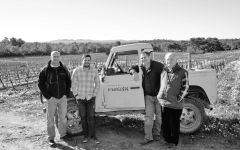Juliette la Sangliere Rose 2020
-
Wilfred
Wong



Product Details
Your Rating
Somm Note
Winemaker Notes
Juliette is a delicious and crisp rose wine that has an initial fruit-forward taste of raspberries and berries that give the wine an attractive open feel. Juliette is refreshing and elegant, bone dry rosé wine, with layers of lively fruit and a bright, smooth finish – just the way a true rosé wine from Southern France should be.
While Juliette serves an excellent standalone aperitif wine, Juliette is also an exceptional food wine that pairs with so many different types of cuisines. Juliette is a perfect pair for grilled fish, seafood, steamed fish, lobster, shellfish, bouillabaisse, and other traditional Provençal cuisines.
Professional Ratings
-
Wilfred Wong of Wine.com
COMMENTARY: The 2020 La Sanglière Juliette Rosé is light, steady, and attractive. TASTING NOTES: This wine offers pleasing aromas and flavors of dried earth, spice, and red cherries. Serve it with a plate of sashimi. (Tasted: May 16, 2021, San Francisco, CA)




Juliette la Sangliere, in Provence is located on 42 hectares of nationally protected land. The winery is 30-km from Saint Tropez and halfway between Marseille and Nice, the proximity to the sea creates an ideal microclimate to cultivate the grape varietals used to produce Juliette Rosé.
Remy Devictor, head winemaker at Juliette la Sangliere, grew up in the heart of Provence in the beautiful, ancient village of Sault, where his grandfather and father were working as agricultural engineers in the lavender industry. At the age of 13, Remy was introduced to the wine world when his father purchased land in the National Park on the Mediterranean coastline and set up the winery Juliette la Sangliere. In 1990, after graduating from the Enology College in Toulon, Remy joined the family business at Sanglière, performing different roles, such as viticulture and winemaking, as well as developing the broader range of estate wines. Eventually, Remy inherited the role of Head Winemaker and expanded the Sanglière portfolio to include some of the most prestigious wines in the Provence region.
Remy is committed to passing the farming and production practices, as well as values instilled by his father, into the hands of the third generation of passionate Sanglière winemakers, his son, Pierre Devictor.

Whether it’s playful and fun or savory and serious, most rosé today is not your grandmother’s White Zinfandel, though that category remains strong. Pink wine has recently become quite trendy, and this time around it’s commonly quite dry. Since the pigment in red wines comes from keeping fermenting juice in contact with the grape skins for an extended period, it follows that a pink wine can be made using just a brief period of skin contact—usually just a couple of days. The resulting color depends on grape variety and winemaking style, ranging from pale salmon to deep magenta.

A sunny land braced by the influence of the Mediterranean Sea, the South of France extends from the French Riviera in the East to the rugged and mountainous Spanish border in the West. This expansive and stunning region remains the source of France's finest rosé and fortified wines, while the red and white wines continue to gain respect.
Provence, located farthest east, is revered for dry, elegant and quenching rosé wines, which make up the vast majority of the region’s production. These are typically blends of Mourvèdre, Grenache, Cinsault, Tibouren and other varieties.
Moving west from the Rhône Valley, spanning the Mediterranean coast to the Pyrenees mountains of Roussillon, Languedoc’s terrain is generally flat coastal plains. Virtually every style of wine is made in Languedoc; most dry wines are blends with varietal choice strongly influenced by the neighboring Rhône Valley.
Bordered by the rugged eastern edge of the Pyrenees Mountains and intense sunshine, Roussillon is largely defined by Spanish influence. The arid, exposed, steep and uneven valleys of the Pyrénées-Orientales zone guarantee that grape yields are low and berries are small and concentrated. While historically recognized for the vins doux naturels of Rivesaltes, Banyuls and Maury, the region’s dry reds are beginning to achieve the notoriety the deserve.
A catchall term for the area surrounding the Languedoc and Roussillon, Pays d’Oc is the most important IGP (Indication Géographique Protégée) in France, producing nearly all of France’s wine under the IGP designation.
